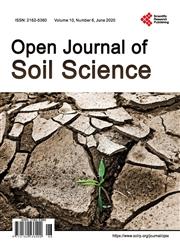Influence of Potassium Nutrition and Exogenous Organic Acids on Iron Uptake by Monocot and Dicot Plants
引用次数: 5
Abstract
Iron (Fe) is a vital element for the survival and proliferation of all plants; therefore, Fe-biofortification by the application of chemical and organic fertilizers is being as an effective approach to fight hidden hunger retards the growth and development of crop plants. Two experiments were carried out to investigate the effect of potassium and exogenous organic acids on iron uptake by two different plants: one is monocotyledon, maize (Zea mays L.) and the second is dicotolydon pea (Pisum sativum L.) grown under controlled conditions. The seedlings were grown in sand culture in a greenhouse experiment and irrigated with one-tenth strength modified nutrient solution of Hoagland and Arnon as a base solution (pH 7.5), containing different iron treatments (0, 1, and 5 ppm as FeSO4·7H2O) combined with potassium nutrition (0, 5, 10, and 50 ppm as K2SO4). After 30 days, the best interaction treatment was selected for further experiment including 5.0 ppm Fe as FeSO4.7H2O and 50 ppm K as K2SO4 in combination with 1 × 10-5 mole/liter of one of the following organic acids: Citric acid, Oxalic acid, Formic acid, Acetic acid, Propionic acid, Tartaric acid, Succinic acid, Fumaric acid, Malic acid, Glutamic acid, besides the free organic acid nutrient solution as a control. Results revealed that the interaction between 5.0 ppm Fe and 50 ppm K was the best interaction treatment for increasing biomass production and iron uptake of maize and pea seedlings under applied condition. Furthermore, exogenous application of organic acids improves uptake and translocation of nutrient such as iron, potassium and phosphorus by the maize and pea plants. In conclusion, potassium nutrition and exogenous organic acids have the potential to stimulate Fe-uptake of monocot and dicot plants and mediate iron-biofortified crops.钾营养和外源有机酸对单子叶和双子叶植物铁吸收的影响
铁(Fe)是所有植物生存和繁殖的重要元素;因此,通过施用化肥和有机肥来生物强化铁是对抗隐性饥饿的有效途径,它阻碍了作物的生长发育。以单子叶玉米(Zea mays L.)和双子叶豌豆(Pisum sativum L.)为试验材料,研究了钾和外源有机酸对两种不同植物铁吸收的影响。幼苗在温室砂培中生长,以1 / 10强度的Hoagland和Arnon改良营养液(pH 7.5)作为基础溶液进行灌溉,其中含有不同的铁处理(0、1和5 ppm的FeSO4·7H2O)和钾营养(0、5、10和50 ppm的K2SO4)。30 d后,选择最佳互作处理,以5.0 ppm Fe为FeSO4.7H2O, 50 ppm K为K2SO4,与1 × 10-5 mol /l有机酸(柠檬酸、草酸、甲酸、乙酸、丙酸、酒石酸、丁二酸、富马酸、苹果酸、谷氨酸)结合,并以游离有机酸营养液为对照。结果表明,在施用条件下,5.0 ppm Fe与50 ppm K互作是提高玉米和豌豆幼苗生物量和铁吸收量的最佳互作处理。此外,外源施用有机酸可以促进玉米和豌豆对铁、钾和磷等营养物质的吸收和转运。综上所述,钾营养和外源有机酸有可能刺激单子叶和双子叶植物对铁的吸收,并介导铁生物强化作物。
本文章由计算机程序翻译,如有差异,请以英文原文为准。
求助全文
约1分钟内获得全文
求助全文

 求助内容:
求助内容: 应助结果提醒方式:
应助结果提醒方式:


